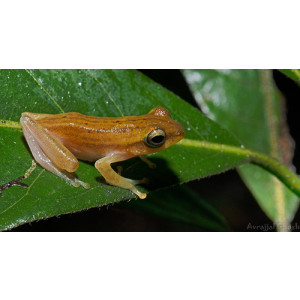Large Tree Frog Did you see this animal?
Scientific Name : Rhacophorus maximus
Family : Rhacophoridae
Order : Anura
Class : Amphibia
Phylum : Chordata
Other Name : Large Tree Frog
Habitat : Nocturnal/Forests
Description : Large tree frog is found in primary and secondary rainforests at elevations between 200 and 1,600 meters above sea level.
Females measuring up to 11 centimeters in length and males slightly smaller at around 9 centimeters. It has bright green skin with black spots and a white underside. Its eyes are large and round, and it has elongated toes that are webbed at the base, allowing it to glide through the air.
It has the ability to glide through the air. It does this by launching itself from a high perch, spreading out its webbed toes and using them to create a parachute-like structure that slows its descent. This enables the frog to travel a distance of up to 15 meters through the air in a single glide.
It is primarily nocturnal and feeds on insects, spiders, and other small invertebrates. Breeding occurs in the rainy season, with males calling to attract females to breeding sites, usually temporary pools or puddles. Females lay their eggs in foam nests attached to vegetation overhanging the water. The tadpoles hatch and drop into the water below, where they undergo metamorphosis into juvenile frogs.
Male frogs are territorial and will defend their breeding sites from other males. They use aggressive displays and vocalizations to deter intruders.
Despite its unique ability to glide through the air,it is currently listed as Near Threatened. Due to habitat loss and fragmentation caused by deforestation and agricultural expansion its population is getting lesser.
Females measuring up to 11 centimeters in length and males slightly smaller at around 9 centimeters. It has bright green skin with black spots and a white underside. Its eyes are large and round, and it has elongated toes that are webbed at the base, allowing it to glide through the air.
It has the ability to glide through the air. It does this by launching itself from a high perch, spreading out its webbed toes and using them to create a parachute-like structure that slows its descent. This enables the frog to travel a distance of up to 15 meters through the air in a single glide.
It is primarily nocturnal and feeds on insects, spiders, and other small invertebrates. Breeding occurs in the rainy season, with males calling to attract females to breeding sites, usually temporary pools or puddles. Females lay their eggs in foam nests attached to vegetation overhanging the water. The tadpoles hatch and drop into the water below, where they undergo metamorphosis into juvenile frogs.
Male frogs are territorial and will defend their breeding sites from other males. They use aggressive displays and vocalizations to deter intruders.
Despite its unique ability to glide through the air,it is currently listed as Near Threatened. Due to habitat loss and fragmentation caused by deforestation and agricultural expansion its population is getting lesser.
Distribution in Bangladesh
References:
description written by: Md. Shalauddin, Department of Zoology, Jagannath University, Dhaka. Information sources: IUCN Red List Bangladesh-2015, Hasan 2014, Khan 2018 (Photographic guide to the wildlife of Bangladesh).photo credit:martinmandak(www.inaturalist.org/people/martinmandak),photo copyright: iNaturalist. more information please contact with us.
description written by: Md. Shalauddin, Department of Zoology, Jagannath University, Dhaka. Information sources: IUCN Red List Bangladesh-2015, Hasan 2014, Khan 2018 (Photographic guide to the wildlife of Bangladesh).photo credit:martinmandak(www.inaturalist.org/people/martinmandak),photo copyright: iNaturalist. more information please contact with us.



















